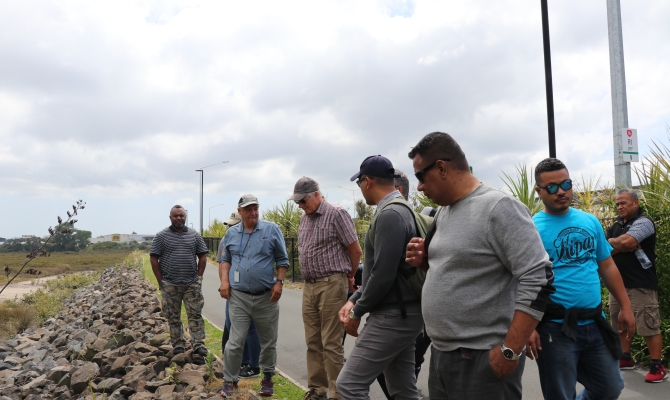
Regional participants attending the Strategic Environment Assessment (SEA) consultation in Auckland, New Zealand, went on a technical visit to the Auckland SH16 Causeway Upgrade Project. The particular relevance of this project to the Pacific region is its location in a tidal/mangrove marine environment and highlighting how the adaptation measures in place are built to counter sea-level rise and storm events.
Twenty participants from 11 Pacific island countries and territories attended the regional consultation to review the draft Strategic Environment Assessment (SEA) Guidelines held on 26 November 2019 in Auckland New Zealand.
The Pacific participants were welcomed by the team from New Zealand Transport Agency (NZTA) consisting of Mr David Greig, Principal Environmental Specialist, Ms Rebekah Pokura-Ward, Project Director NZ Transport Agency, Mr Peter Mitchell, Stormwater Asset Manager (Auckland System Management) and Mr Raymond Change, Environment and Sustainability Manager (Auckland System Management).
The Causeway Upgrade Project is raising the motorway 1.5 metres to prevent flooding and widening it to provide additional capacity and bus shoulder lanes in both directions. The cycleway alongside the motorway is being raised, widened and upgraded as well.
The work is carried out in stages to minimise disruptions to the community, the environment and traffic. A key consideration of the project is the Motu Manawa – Pollen Island Marine Reserve which runs alongside the project. The project team ensures construction work has as little impact as possible on the marine reserve.
The project complements the strategic planning for transport in the NZTA and their approach covers community consultation, development and monitoring of construction activities, environmental management, planning and implementation, addressing social benefit components and ongoing monitoring of the environmental management and ways of working with mana whenua.
Ms Rebekah Pokura- Ward, Project Director, NZTA, presented on the importance of social inclusion in the environment impact assessment process. She said it is important to hold meetings with the community to document concerns and map out potential cultural and ecological sites to address in the project. The community consultations included visiting markets and other gathering places to engage with people who would not normally attend the town hall style engagement. “Identifying local artisans and traditional knowledge that can be used to improve the project and woven into the design and construction of the development is vital.”
The field day was facilitated by Richard Morgan and Nick Taylor of NZAIA who were also part of the greeting team at the NZTA conference room.
The technical visit helped developed knowledge and skills around environmental assessment and management for infrastructure projects. The site visit benefitted the Pacific delegation through networking with EIA practitioners in New Zealand including a group of Pacific Islanders working in Auckland as planners.
The day concluded with a reception at Boffa-Miskell hosted by Mr. Ian Boothroyd who welcomed the delegates to Auckland and engaged with them to discuss the use of EIA, social engagement and other planning tools for improving sustainable development.
SPREP facilitated the attendance of 11 Pacific islanders to the SEA consultations. The SPREP team was lead Director General Mr. Kosi Latu supported by Environmental Planning Adviser Mr Jope Davetanivalu, Environmental Assessment Planning Officer, Dr Gregory Barbara, and EMG Programme Assistant, Ms Faasipa Lemalu. The consultation was made possible with funding support from the Government of Sweden through the UN Environment Programme.